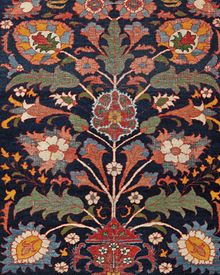Difference between revisions of "Iraqi Carpet"
| Line 43: | Line 43: | ||
==Bibliography== | ==Bibliography== | ||
* Peter F. Stone. 2013. ''Oriental Rugs: An Illustrated Lexicon of Motifs, Materials, and Origins''. North Clarendon: Tuttle. | * Peter F. Stone. 2013. ''Oriental Rugs: An Illustrated Lexicon of Motifs, Materials, and Origins''. North Clarendon: Tuttle. | ||
| + | |||
{{Template:Worlds Carpets}} | {{Template:Worlds Carpets}} | ||
| − | [[Category: | + | [[Category:Worlds Carpets]] |
[[fa:فرش عراق]] | [[fa:فرش عراق]] | ||
Latest revision as of 12:08, 14 September 2020
| Iraqi Carpet | |
|---|---|
 | |
| General information | |
| Name | Iraqi Carpet |
| Original name | فرش عراق، قالی عراق |
| Alternative name(s) | Iraqi Rug |
| Origin | |
| Technical information | |
| Common designs | Geometric |
| Foundation material | Wool |
| Knot type | Asymmetrical (Persian), Symmetrical (Turkish) |
Iraqi Carpet or Iraqi Rug is one of the eastern rugs that woven in Iraq.
Rugs are woven in Kurdish communities of northern Iraq. Kilims are woven in the town of Hai in southern Iraq and these are termed “Hai.” These are tapestry-woven in two vertical pieces and joined in the center. They have geometric designs. “Samawas” are embroidered blankets and rugs on a wool foundation. These are woven in villages of southern Iraq. Colors are bright and designs consist of densely-arranged geometric, floral, and animal motifs and images. Human figures are also shown. Since the 1930s, some pile rugs have been woven in Baghdad prisons. Designs have included maps of Iraq, the royal coat of arms, and ancient buildings. The quality of these rugs has declined in current production.
Ancient pile carpet fragments have been unearthed at the At-Tar Caves in Iraq. These fragments have been dated from the third century b.c.e. to the third century c.e. Different fragments were woven with the asymmetric knot, the symmetric knot, the Coptic knot, or the Senneh loop knot (an unusual knot producing pile on both sides of the fabric) and an unknotted cut loop.[1]
References
- ↑ Stone, 2013, 136
Bibliography
- Peter F. Stone. 2013. Oriental Rugs: An Illustrated Lexicon of Motifs, Materials, and Origins. North Clarendon: Tuttle.